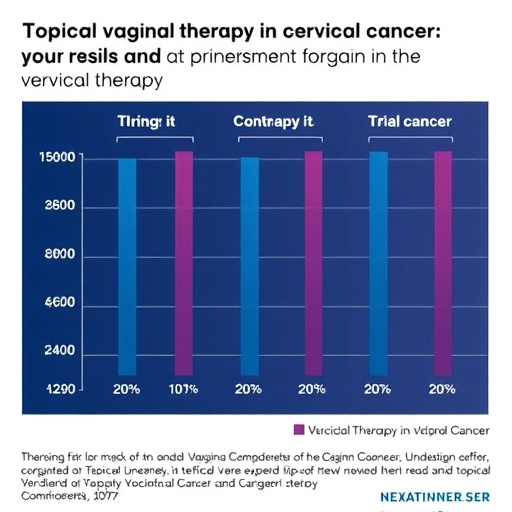Emerging Paradigms in Cervical Cancer Treatment: Topical Vaginal Drug Therapy as a Novel Frontier
Cervical cancer remains a formidable challenge in global oncology, particularly affecting women in low-resource settings where access to comprehensive treatment modalities is limited. The traditional regimen has largely relied on systemic chemotherapy, radiotherapy, and surgical interventions, which, despite their efficacy, often leave patients grappling with adverse effects and compromised quality of life. Recently, a groundbreaking review published in Medical Oncology has cast a spotlight on an innovative approach that could revolutionize cervical cancer management: topical vaginal drug therapy. This method, which involves localized application of therapeutic agents directly to the cervix, offers a promising avenue to enhance drug concentration at the tumor site while potentially minimizing systemic toxicity.
Topical vaginal drug therapy capitalizes on the unique anatomical and physiological properties of the vaginal mucosa, which provides a direct route to cervical tissue, facilitating enhanced local drug bioavailability. Unlike systemic chemotherapy, which disseminates drugs throughout the body, topical delivery aims to concentrate therapeutic agents precisely where they are needed, thereby elevating efficacy and reducing collateral damage. This localized administration route could address a significant clinical gap by offering an alternative for patients who are not ideal candidates for systemic therapies due to comorbidities or adverse drug reactions.
The reviewed studies highlight a spectrum of therapeutic agents formulated for vaginal application, including novel nanoparticles, chemotherapeutic drugs, and biological agents such as immunomodulators and gene therapy vectors. Nanotechnology, in particular, underpins many of these advancements. Engineered nanoparticles can improve drug solubility, stability, and controlled release, the hallmarks of an optimized topical delivery system. Sustained release formulations enable consistent drug exposure, crucial for disrupting cancer cell proliferation while sparing healthy tissues.
Clinical trials examining topical vaginal therapy in cervical cancer have yielded encouraging preliminary outcomes. In early-phase trials, patients treated with vaginally administered chemotherapeutic agents demonstrated significant tumor regression with a markedly reduced incidence of systemic side effects compared to conventional chemotherapy. These promising results underscore topical therapy’s potential to become a frontline adjunct or even a standalone treatment modality in select cases, particularly for early-stage or recurrent cervical tumors.
The pharmacokinetic profiles emerging from these investigations reveal rapid local absorption coupled with minimal systemic drug levels. This pharmacological behavior is advantageous not only for efficacy but also in mitigating common chemotherapy-associated toxicities such as myelosuppression, gastrointestinal distress, and nephrotoxicity. Additionally, the ability to bypass hepatic first-pass metabolism when drugs are applied vaginally may enhance therapeutic bioavailability, allowing for lower dosages and improved patient compliance.
Preclinical models have been instrumental in elucidating the mechanisms of drug uptake and action in the vaginal-cervical milieu. Animal studies using engineered drug carriers have demonstrated targeted delivery to neoplastic cells with negligible penetration into adjacent healthy tissues. These findings provide a mechanistic basis for the observed clinical benefits and inform the design of next-generation topical formulations incorporating tumor-specific ligands or stimuli-responsive elements for precision targeting.
Despite the palpable promise, several challenges temper enthusiasm and demand rigorous investigation. Vaginal mucosal barriers, variability in drug retention time due to secretions and physiology, and patient adherence to application protocols present critical hurdles. Moreover, long-term safety data on repeated mucosal exposure to potent cytotoxic agents remain sparse. Addressing these complexities requires integrated efforts spanning pharmaceutical sciences, oncology, and gynecology to refine delivery systems and define optimal therapeutic windows.
Another intriguing dimension brought to light by the review is the potential role of topical drug therapy in modulating the tumor microenvironment. Immunotherapeutic agents applied locally can reshape the immune landscape within cervical lesions, enhancing antigen presentation and stimulating cytotoxic T-cell responses. This immunomodulatory capacity not only augments direct anticancer effects but may also synergize with systemic immunotherapies, heralding combination regimens that leverage both local and systemic immune mechanisms.
The implications of these insights extend beyond clinical practice into public health paradigms. In resource-limited settings, where access to advanced oncology care is constrained, topical vaginal drug therapy may represent a cost-effective, minimally invasive approach that can be deployed in outpatient or even community settings. This democratization of cancer care aligns with global health strategies emphasizing decentralized treatment and improved patient autonomy.
Current efforts are underway to develop standardized protocols and formulation guidelines, integrating patient feedback and pharmacodynamic monitoring to optimize treatment adherence and outcomes. Digital health tools, including mobile applications for treatment reminders and symptom tracking, have been proposed to bolster compliance and real-time monitoring, enhancing the safety profile of these emerging therapies.
Looking forward, the integration of precision medicine into topical vaginal therapy holds transformative potential. Molecular profiling of cervical tumors can guide the selection of therapeutic agents tailored to individual tumor genetics and resistance patterns, elevating treatment personalization. Innovations such as biodegradable implants and smart drug delivery platforms responsive to tumor microenvironmental cues represent the next evolution in this field.
In summary, topical vaginal drug therapy emerges from this comprehensive review as a beacon of hope amidst the evolving landscape of cervical cancer treatment. By enabling potent, localized drug delivery with diminished systemic toxicity, it promises to redefine therapeutic strategies and improve the lives of countless women worldwide. While hurdles remain, the marriage of cutting-edge pharmaceutical technology with clinical oncology heralds a new chapter in the battle against cervical cancer—one written on the very tissue it seeks to heal.
Subject of Research:
Topical vaginal drug therapy in the management of cervical cancer, focusing on clinical trials and preclinical evidence for localized drug delivery strategies.
Article Title:
Topical vaginal drug therapy in cervical cancer management: a review of clinical trials and preclinical evidence.
Article References:
Li, C., Zhu, Y., Li, N. et al. Topical vaginal drug therapy in cervical cancer management: a review of clinical trials and preclinical evidence. Med Oncol 42, 523 (2025). https://doi.org/10.1007/s12032-025-02983-z
Image Credits:
AI Generated




